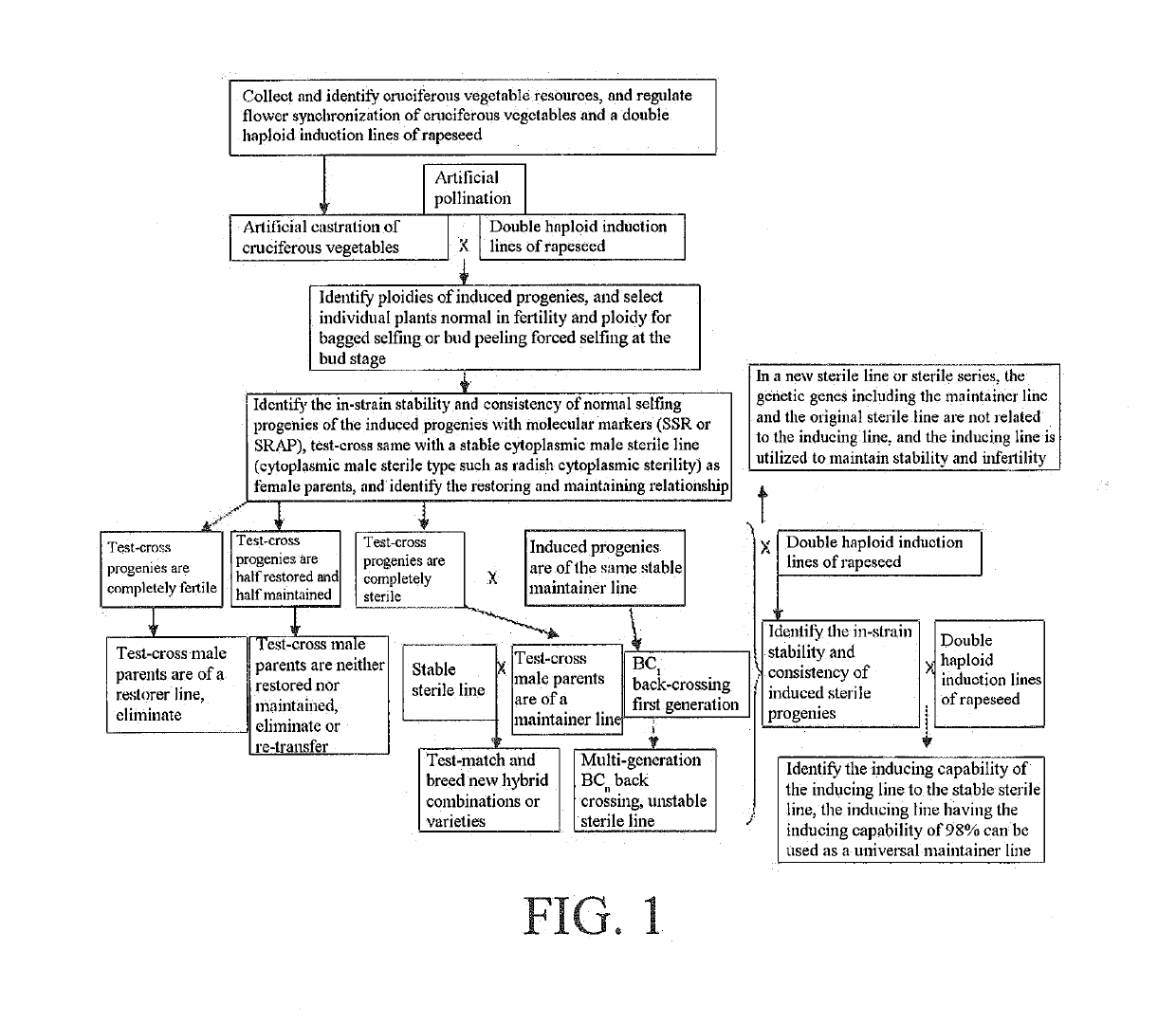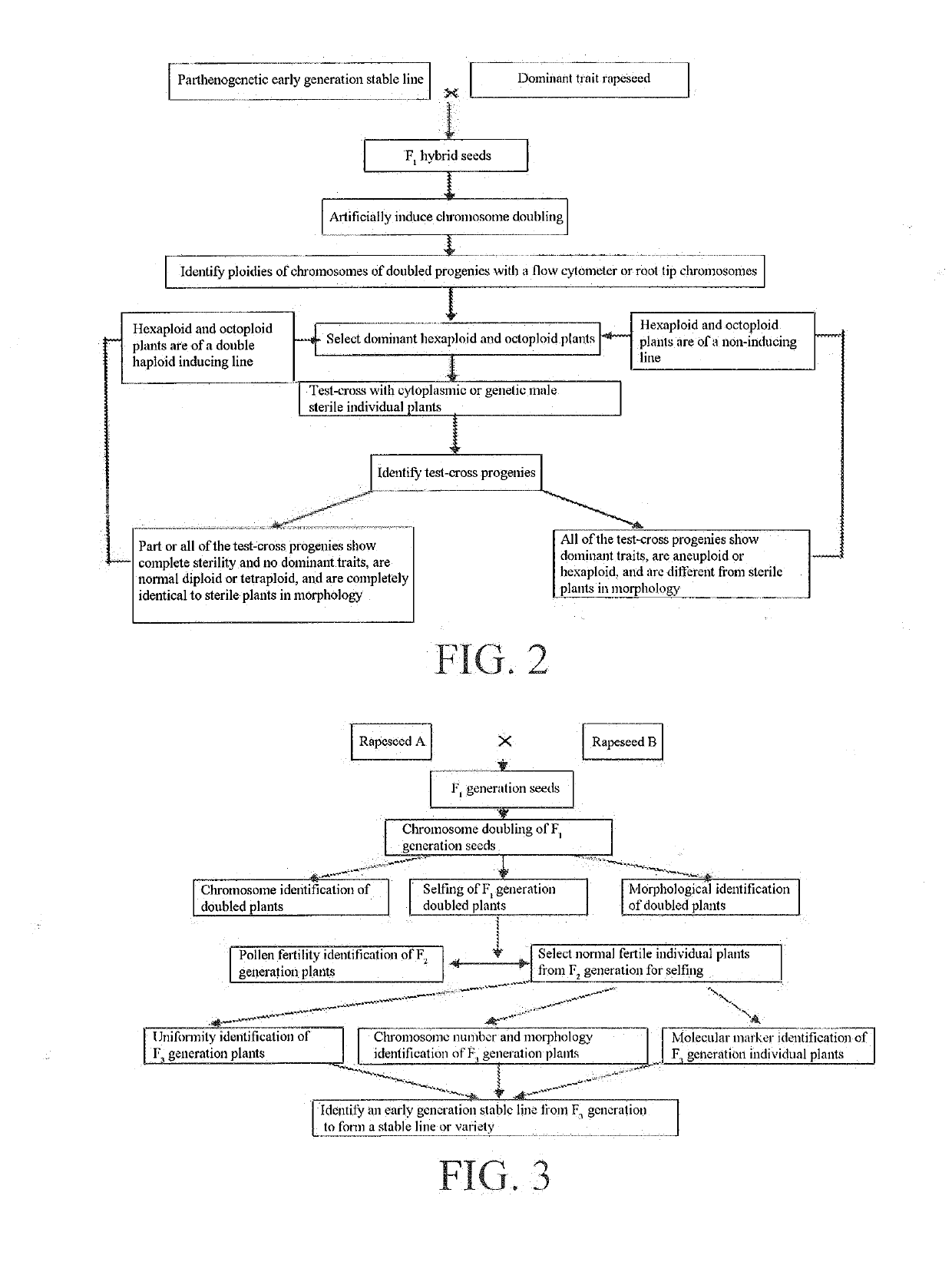Method for breeding cruciferous vegetable materials and varieties with double haploid induction line of rapeseed
a technology of rapeseed and cruciferous vegetable, applied in the field of agriculture, can solve the problems of low efficiency of breeding new hybrid combinations or varieties, and achieve the effect of improving the efficiency and pertinence of breeding materials, and quick and effective breeding of cruciferous vegetable materials and varieties
- Summary
- Abstract
- Description
- Claims
- Application Information
AI Technical Summary
Benefits of technology
Problems solved by technology
Method used
Image
Examples
embodiment 1
[0068]Referring to FIG. 1, FIG. 2, FIG. 5 and FIG. 7, Brassica oleracea resources collected for many years were planted in field, and the traits were observed. It was discovered that Gan 336 had a good appearance, high yield and disease resistance, but was unstable in groups with genetic separation. Seeds were sowed in mid-August of last year, seedlings were planted in mid-September and replanted in late December while vegetative growth was removed, Gan 33.6 was artificially castrated during the early flowering stage at the end of March of the first year and bagged for isolation, and the Gan 336 was induced by a double haploid induction line of rapeseed Y3380 after being castrated for 3 days, pollinated and bagged for isolation. The induced progenies were sowed in field in August of the same year, and 25 progenies were discovered to be completely identical to Brassica oleracea in appearance and identified to be all diploids with a flow cytometer. The progeny individual plants were s...
embodiment 2
[0107]Referring to FIG. 1, FIG. 2, FIG. 4, FIG. 5 and FIG. 8, in order to transform the original Brassica oleracea sterile line and improve the combining ability, disease resistance, storage and transportation of the sterile line, a Brassica oleracea self-incompatible line (high combining ability line) Gan 121 was crossed with a storage and transportation resistant line Gan 051, the hybrid F1 generation was artificially castrated at the flowering stage and induced with a double haploid induction line of rapeseed Y3560 by pollination, and 15 individual plants were obtained at an F2 generation (induced F1 generation). The survey found that the 15 individual plants were all in the shape of Brassica oleracea, and were all diploid. The 15 individual plants were bagged (with buds peeled) and selfed, pollen was taken and test-crossed with a Brassica oleracea sterile line (radish cytoplasmic male sterile line) Rongluo A019, the consistency of in-strain stability of the selfed progenies was ...
embodiment 3
[0108]Referring to FIG. 1, FIG. 2, FIG. 4, FIG. 5 and FIG. 9, round white radish Y23 was crossed with Korean radish 1122, the F1 generation was artificially castrated at the flowering stage and pollinated with the double haploid induction line of rapeseed Y3380, the ploidies of induced progenies of the F2 generation were identified with a flow cytometer at the seedling stage to find 10 individual plants, in which 1 individual plant was haploid, the remaining 9 were diploid, and were all in the shape of radish. The 9 individual plants were bagged for selfing at the flowering stage, the in-strain consistency and stability of the selfed progenies were identified to find that the 9 strains were highly uniform in in-strain consistency and stability, the pollen of the 9 strains was respectively test-crossed with a radish sterile line Rongluo A001, and the consistency and ploidy of the test-crossed progenies were identified to find that the 9 test-crossed progenies were all sterile, where ...
PUM
 Login to View More
Login to View More Abstract
Description
Claims
Application Information
 Login to View More
Login to View More - R&D
- Intellectual Property
- Life Sciences
- Materials
- Tech Scout
- Unparalleled Data Quality
- Higher Quality Content
- 60% Fewer Hallucinations
Browse by: Latest US Patents, China's latest patents, Technical Efficacy Thesaurus, Application Domain, Technology Topic, Popular Technical Reports.
© 2025 PatSnap. All rights reserved.Legal|Privacy policy|Modern Slavery Act Transparency Statement|Sitemap|About US| Contact US: help@patsnap.com



